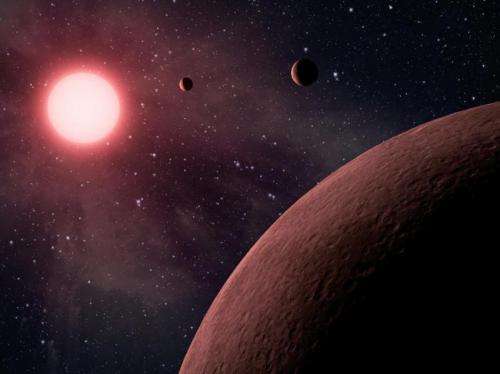October 10, 2014 report
Simulation suggests warm Jupiter exoplanets can be pushed closer to their star by another planet

(Phys.org) —A pair of astronomers with the University of California has demonstrated via computer simulation that the reason some hot or warm Jupiter exoplanets orbit their star so closely is because they are pulled there by another planet. In their paper published in the journal Science, Rebekah Dawson and Eugene Chiang describe their simulations and what their observations revealed.
A couple of decades ago, astronomers discovered that some Jupiter sized exoplanets orbited very closely to their stars. They also found that some of those gaseous planets were also hotter than Jupiter, and were given names to indicate how much: warm or hot. This uncovered a puzzle because solar system and planetary formation theories suggest that large gassy planets almost certainly form very far away from their star. So, what caused them to move closer?
Prior research has hinted that the answer may lie with other planets in the same system causing some sort of gravitational influence that might cause movement towards a central star. In this latest effort, the research pair carried this line of thinking further by constructing multiple simulations of systems where there is a warm Jupiter and another planet large enough to exert influence with its gravity. For each such system, they ran approximately 1000 simulations, modifying the parameters as they went mimicking the passage of 200 million years. They found that if two planets did not lie in the same plane (with angles ranging from 35 to 65 degrees) it was possible for the second planet to pull the warm or hot Jupiter closer towards the central star under certain circumstances.
While it was once thought that that most if not all planetary systems were flat planed, findings over the past several years have shown that the flat plan demonstrated by our own solar system is not necessarily the norm. Many non-planer systems have been found, leading to theories being developed to explain how it may happen. They all start by suggesting planets form on a plane due to accretion from disc material, thus, planets that orbit their star out of that plane must get pushed there somehow—current thinking is that it's likely due to the planets pulling on one another, particularly when some develop later than others.
More information: A class of warm Jupiters with mutually inclined, apsidally misaligned close friends, Science 10 October 2014: Vol. 346 no. 6206 pp. 212-216. DOI: 10.1126/science.1256943
ABSTRACT
The orbits of giant extrasolar planets often have surprisingly small semimajor axes, large eccentricities, or severe misalignments between their orbit normals and their host stars' spin axes. In some formation scenarios invoking Kozai-Lidov oscillations, an external planetary companion drives a planet onto an orbit having these properties. The mutual inclinations for Kozai-Lidov oscillations can be large and have not been confirmed observationally. Here we present evidence that observed eccentric warm Jupiters with eccentric giant companions have mutual inclinations that oscillate between 35° and 65°. Our inference is based on the pairs' observed apsidal separations, which cluster near 90°. The near-orthogonality of periapse directions is effected by the outer companion's quadrupolar and octupolar potentials. These systems may be undergoing a stalled version of tidal migration that produces warm Jupiters over hot Jupiters, and they provide evidence for a population of multiplanet systems that are not flat and have been sculpted by Kozai-Lidov oscillations.
Journal information: Science
© 2014 Phys.org



















